
The Red Line is a rapid transit line operated by the Massachusetts Bay Transportation Authority (MBTA) as part of the MBTA subway system. The line runs south and east underground from Alewife station in North Cambridge through Somerville and Cambridge, surfacing to cross the Longfellow Bridge then returning to tunnels under Downtown Boston. It continues underground through South Boston, splitting into two branches on the surface at JFK/UMass station. The Ashmont branch runs southwest through Dorchester to Ashmont station, where the connecting light rail Ashmont–Mattapan High Speed Line continues to Mattapan station. The Braintree branch runs southeast through Quincy and Braintree to Braintree station.

The Blue Line is a rapid transit line in the Greater Boston metropolitan area, one of four rapid transit lines operated by the Massachusetts Bay Transportation Authority (MBTA). It runs from Bowdoin station in downtown Boston under Boston Harbor to East Boston and Revere on the inner North Shore, where it terminates at Wonderland. The stop at Airport Station, by way of a free shuttle bus, is one of two rapid transit connections to Logan International Airport. In 1967, during a systemwide rebranding, the line was assigned the blue color because it passes under the Boston Harbor. With an end-to-end travel time of less than twenty minutes, the Blue Line is the shortest of Boston's heavy-rail lines and the only line to have both third rail and overhead catenary sections.

Park Street station is an MBTA subway station in Boston, Massachusetts. It is located at the intersection of Park Street and Tremont Street at the eastern edge of Boston Common in Downtown Boston. One of the two oldest stations on the "T", and part of the oldest subway line in the United States, Park Street is the transfer point between the Green and Red lines, as one of the quartet of "hub stations" on the MBTA subway system. Park Street is the fifth-busiest station in the MBTA network, with an average of 16,571 entries each weekday in FY2019.
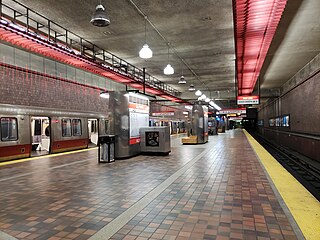
Alewife station is a Massachusetts Bay Transportation Authority (MBTA) intermodal transit station in the North Cambridge neighborhood of Cambridge, Massachusetts. It is the northwest terminal of the rapid transit Red Line and a hub for several MBTA bus routes. The station is at the confluence of the Minuteman Bikeway, Alewife Linear Park, Fitchburg Cutoff Path, and Alewife Greenway off Alewife Brook Parkway adjacent to Massachusetts Route 2, with a five-story parking garage for park and ride use. The station has three bike cages. Alewife station is named after nearby Alewife Brook Parkway and Alewife Brook, themselves named after the alewife fish.

Harvard station is a rapid transit and bus transfer station in Cambridge, Massachusetts. Located at Harvard Square, it serves the MBTA's Red Line subway system as well as MBTA buses. Harvard averaged 18,528 entries each weekday in FY2019, making it the third-busiest MBTA station after Downtown Crossing and South Station. Five of the fifteen key MBTA bus routes stop at the station.
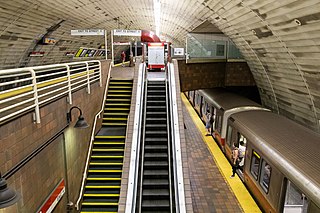
Porter station is a Massachusetts Bay Transportation Authority (MBTA) transit station in Cambridge, Massachusetts. It serves the Red Line rapid transit line, the MBTA Commuter Rail Fitchburg Line, and several MBTA bus lines. Located at Porter Square at the intersection of Massachusetts and Somerville Avenues, the station provides rapid transit access to northern Cambridge and the western portions of Somerville. Porter is 14 minutes from Park Street on the Red Line, and about 10 minutes from North Station on commuter rail trains. Several local MBTA bus routes also stop at the station.

Davis station is an underground Massachusetts Bay Transportation Authority (MBTA) Red Line rapid transit station located at Davis Square in Somerville, Massachusetts. The accessible station has a single island platform for the Red Line, as well as a dedicated busway on the surface. It opened in 1984 as part of the Red Line Northwest Extension project.

Central station is a Massachusetts Bay Transportation Authority (MBTA) rapid transit station in Cambridge, Massachusetts. It serves the Red Line and has a street-level terminal for the MBTA bus system. It is located at the intersection of Massachusetts Avenue with Western Avenue, Prospect Street, and Magazine Street at Central Square.

Kendall/MIT station is an underground rapid transit station in Cambridge, Massachusetts. It serves the MBTA Red Line, Located at the intersection of Main Street and Broadway, it is named for the primary areas it serves - the Kendall Square business district and the Massachusetts Institute of Technology (MIT). Opened in March 1912 as part of the original Cambridge subway, Kendall/MIT has two side platforms serving the line's two tracks. The Kendall Band, a public art installation of hand-operated musical sculptures, is located between the tracks in the station with controls located on the platforms. Kendall/MIT station is accessible. With 17,018 weekday boardings by a FY2019 count, Kendall/MIT has the fourth highest ridership among MBTA subway stations.

Charles/MGH station is a rapid transit station on the MBTA Red Line, elevated above Charles Circle on the east end of the Longfellow Bridge in the West End neighborhood of Boston, Massachusetts. The station is named for Charles Circle and the adjacent Massachusetts General Hospital (MGH) campus. It has two side platforms, with a glass-walled headhouse structure inside Charles Circle. Charles/MGH station is fully accessible.

State station is an underground Massachusetts Bay Transportation Authority (MBTA) rapid transit station located in downtown Boston, Massachusetts. It is the transfer point between the Orange Line and the Blue Line, and one of four "hub stations" on the MBTA subway system. The Orange Line has two side platforms on two levels, while the Blue Line has two side platforms on a single level. The station is fully accessible.

Lechmere station is a Massachusetts Bay Transportation Authority (MBTA) Green Line light rail station in Lechmere Square in East Cambridge, Massachusetts. It is located on the east side of Monsignor O'Brien Highway near First Street, adjacent to the NorthPoint development. The accessible elevated station has a single island platform, with headhouses at both ends. It opened on March 21, 2022, as part of the Green Line Extension (GLX). Lechmere station is served by Green Line D branch and E branch service.

Sullivan Square station is a rapid transit station on the MBTA subway Orange Line, located adjacent to Sullivan Square in the Charlestown neighborhood of Boston, Massachusetts. It is a major transfer point for MBTA bus service, with 12 routes using a two-level busway. The station has two island platforms serving the two active Orange Line tracks plus an unused third track. The Haverhill Line and Newburyport/Rockport Line pass through the station on separate tracks but do not stop.

Bowdoin station is a Massachusetts Bay Transportation Authority (MBTA) rapid transit station in Bowdoin Square in Boston, Massachusetts. The station is the downtown terminus of the Blue Line, part of the MBTA subway system. It has a single wedge-shaped island platform located inside a balloon loop. Bowdoin is the only Blue Line station that is not accessible.
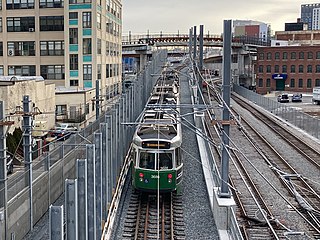
The Green Line Extension (GLX) was a construction project to extend the Massachusetts Bay Transportation Authority (MBTA) Green Line light rail system northwest into Somerville and Medford, two inner suburbs of Boston, Massachusetts. The project opened in two phases in 2022 at a total cost of $2.28 billion. Total ridership on the 4.3-mile (6.9 km) extension is estimated to reach 45,000 one-way trips per day in 2030.
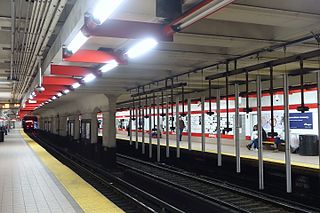
The Kendall Band is a three-part musical sculpture created between 1986 and 1988 by Paul Matisse, who is the grandson of French artist Henri Matisse and stepson of surrealist artist Marcel Duchamp. It is installed between the inbound and outbound tracks of the Massachusetts Bay Transportation Authority's Kendall Station located in Cambridge, Massachusetts near the MIT campus. As of 2007, the art work was seen by an estimated 12,518 riders on an average weekday. It had originally cost $90,000 to construct.

Gift of the Wind is a large-scale public kinetic sculpture, by Susumu Shingu, located in Porter Square, Cambridge, Massachusetts at the Porter, Massachusetts Bay Transportation Authority subway and commuter rail station. The artwork consists of a tall white pole with three red "wings" attached to the top that are "designed to shift in response to the movement of the wind, not only turning clockwise and counterclockwise, but tumbling over and over in various sequences". It is considered by some to be "Cambridge's most visible landmark".

The Davis Square statues, entitled Ten Figures, are life-sized cast concrete public sculpture, created by James Tyler in 1983, located in Davis Square, Somerville, Massachusetts at or near the Davis, Massachusetts Bay Transportation Authority subway station. The statues are mostly based on people who lived near Davis Square in the 1980s. In 1996 bronze "masks" were added to the sculptures to repair damage and deter future vandalism.

Glove Cycle is a 1984 public art installation by Mags Harries, located throughout the Massachusetts Bay Transportation Authority Porter subway and commuter rail station in Porter Square, Cambridge, Massachusetts. The artwork consists of 54 separate bronze pieces and was created with a budget of US$30,000.
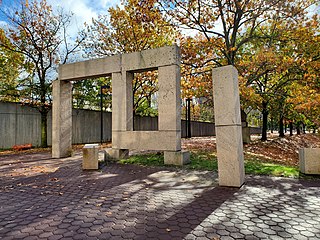
Untitled is a 1985 public art installation by American artist Richard Fleischner located in a courtyard adjacent to Alewife station on the Massachusetts Bay Transportation Authority (MBTA) Red Line in northwest Cambridge, Massachusetts. The artwork – an environmental piece consisting of granite block designs among a landscape – cost $40,000 to create as part of the Arts on the Line program.









































